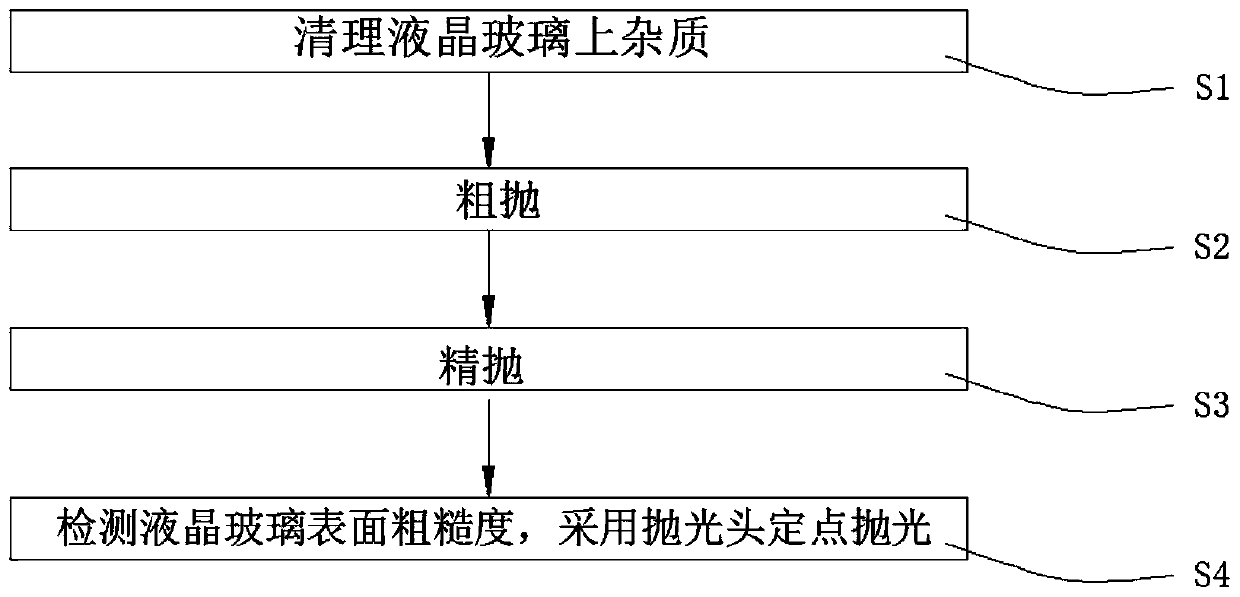Glass polishing process for liquid crystal display production
A liquid crystal glass and liquid crystal screen technology, applied in grinding/polishing equipment, machine tools suitable for grinding workpiece planes, manufacturing tools, etc., can solve the problem of low profit and income of manufacturers, low precision of liquid crystal glass, and large gap in roughness, etc. problem, to achieve the effect of short production time, small gap and high precision
- Summary
- Abstract
- Description
- Claims
- Application Information
AI Technical Summary
Problems solved by technology
Method used
Image
Examples
Embodiment 1
[0033] See figure 1 , The present invention provides a technical solution: a glass polishing process for LCD screen production, including the following steps:
[0034] S1. Clean the impurities on the liquid crystal glass: evenly cover the surface and corners of the liquid crystal glass with the pickling agent, and let it stand for 100 minutes. The coverage standard of the pickling agent is 800ml / m 2 , After the pickling time, use 60℃ hot water to rinse, the rinse time is 90s;
[0035] S2. Rough polishing: Place the liquid crystal glass in the grinding disc, introduce the small particle size polishing powder into the polishing machine, use a fine grinding polishing pad to cyclically polish the liquid crystal glass, the polishing time is 3min / m, and the pressure is 2Mpa;
[0036] S3. Fine polishing: place the liquid crystal glass in an environment of 150℃, pass CO 2 The laser light source is polished, and the laser scanning speed is 15mm / s. After scanning for 20 cycles, stop scanning; ...
Embodiment 2
[0061] See figure 1 The present invention also provides a technical solution: a glass polishing process for the production of liquid crystal screens, which is different from the first embodiment and includes the following steps:
[0062] S1. Clean the impurities on the liquid crystal glass: evenly cover the surface and corners of the liquid crystal glass with the pickling agent, and let it stand for 110 minutes. The coverage standard of the pickling agent is 8250ml / m 2 , After the pickling time, use 65℃ hot water to rinse, the rinse time is 75s;
[0063] S2. Rough polishing: Place the liquid crystal glass in the grinding disc, introduce the small particle size polishing powder into the polishing machine, use a fine grinding polishing pad to cyclically polish the liquid crystal glass, the polishing time is 4min / m, and the pressure is 3Mpa;
[0064] S3. Fine polishing: place the liquid crystal glass in an environment of 200 ℃, pass the CO 2 The laser light source is polished, and the l...
Embodiment 3
[0072] See figure 1 The present invention also provides a technical solution: a glass polishing process for the production of liquid crystal screens, which is different from the first embodiment and includes the following steps:
[0073] S1. Clean the impurities on the liquid crystal glass: evenly cover the surface and corners of the liquid crystal glass with the pickling agent, and let it stand for 120 minutes. The coverage standard of the pickling agent is 800ml / m 2 , After the pickling time, use 70℃ hot water to rinse, the rinse time is 60s;
[0074] S2. Rough polishing: Place the liquid crystal glass in the grinding disc, introduce the small particle size polishing powder into the polishing machine, use a fine grinding polishing pad to circulate the liquid crystal glass, the grinding time is 5min / m, and the pressure is 2Mpa;
[0075] S3. Fine polishing: Place the liquid crystal glass in an environment of 250°C and pass the CO 2 The laser light source is polished, and the laser sc...
PUM
| Property | Measurement | Unit |
|---|---|---|
| Particle size | aaaaa | aaaaa |
Abstract
Description
Claims
Application Information
 Login to View More
Login to View More - R&D Engineer
- R&D Manager
- IP Professional
- Industry Leading Data Capabilities
- Powerful AI technology
- Patent DNA Extraction
Browse by: Latest US Patents, China's latest patents, Technical Efficacy Thesaurus, Application Domain, Technology Topic, Popular Technical Reports.
© 2024 PatSnap. All rights reserved.Legal|Privacy policy|Modern Slavery Act Transparency Statement|Sitemap|About US| Contact US: help@patsnap.com








